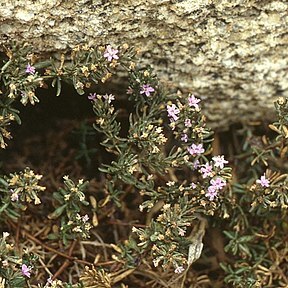Salt-tolerant herbs or small shrubs. Leaves simple, opposite, the pairs united by a small stipular sheath. Flowers solitary or in dichasial cymes, bracteate, sessile, actinomorphic, bisexual (except Nierderleinia). Calyx a pleated tube with 4–7 lobes. Petals 4–7, imbricate, usually free, often spathulate or clawed, many with ligular scale at base of lamina and often decurrent down claw, usually pink or white, rarely red or purple. Stamens 4–24, usually 6, in two whorls; filaments of unequal length, often flattened; anthers versatile, extrorse. Ovary syncarpous, superior, unilocular; style 1, usually branched, the distal part of the branches stigmatic; placentation basal or parietal, placentas 1–6, as many as there are style branches. Fruit a capsule splitting lengthwise into valves and contained within persistent calyx; petals, stamens and style often caducous. Seeds ovoid or cylindrical; embryo straight in mealy endosperm.
Herbs, subshrubs, or shrubs, perennial or, rarely, annual. Stems rounded to noticeably angled. Leaves opposite, simple, petiolate or sessile, <with salt glands>, estipulate, paired leaves connate basally by membranous, sheathing margins with stiff, white hairs, flattened and appressed to stem; petiole narrow to broad, fleshy to flattened and chartaceous; blade margins entire. Inflorescences solitary flowers or terminal or axillary, simple or compound dichasia (frequently with some monochasial branching), bracteate; bracts [2]4, basally connate (rarely incompletely connate). Flowers bisexual [unisexual]; sepals 4–6[–7], persistent, connate, ribbed; petals 4–6[–7], distinct, clawed basally, limb spreading, scalelike appendage or ligule embryo straight; endosperm present.
Stamens usually 6, hypogynous, free or shortly connate at the base; anthers 2-celled, didymous, dehiscing longitudinally
Ovary superior, sessile, 1-celled, with 2–4 parietal placentas; ovules numerous; style simple, filiform
Petals as many as the sepals, free, clawed, with a scale-like appendage on the inside, imbricate
Herbs or shrublets; leaves opposite, exstipulate, often small and ericoid
Flowers actinomorphic, hermaphrodite, solitary r cymose, small
Capsule enclosed in the persistent calyx, opening by valves
Sepals 4–6, persistent, connate, induplicate-valvate
Seeds with endosperm; embryo straight, axile

